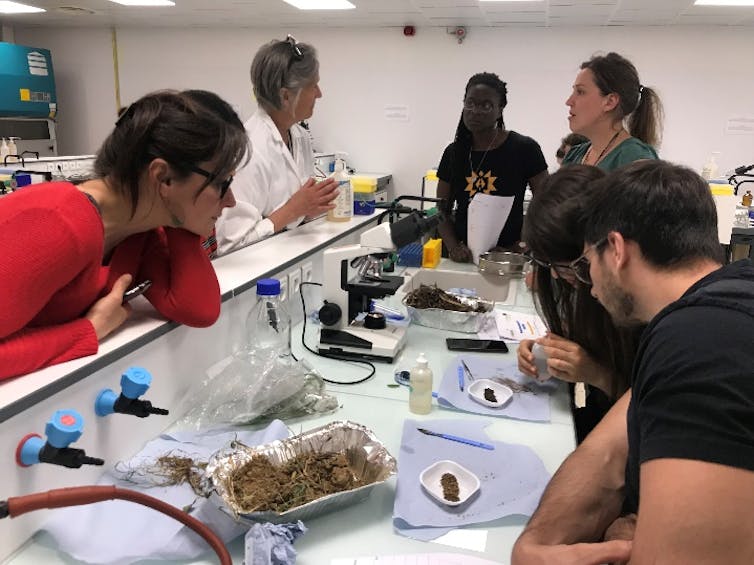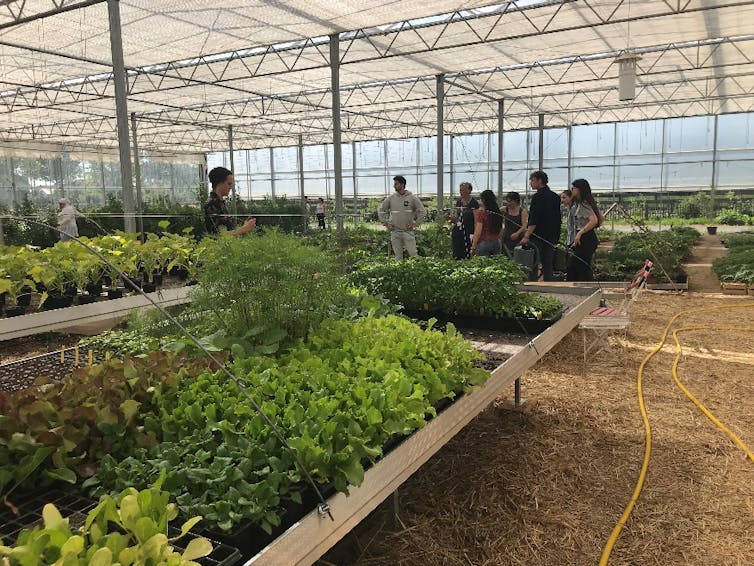Discover the new article by Marie Asma Ben-Othmen and Marie-Pierre Bruyant, respectively Associate professor in charge of the Master of Science Urban Agriculture & Green Cities, and Associate professor in Plant Sciences, for The Conversation.
The new great challenge for cities that want to be sustainable, ecological and resilient is to reconcile two worlds, agricultural and urban. Even if everything seems to separate these forms of space, agriculture and the city are increasingly thought of together in modern, integrated and sustainable urban development models.
Steps are already being taken to strengthen the food function of urban soils, with a view to returning to plant production as close as possible to the places of consumption in the city. However, urban soils do present some surprises: we must ensure their quality and the absence of contaminants before daring to cultivate them and produce plants in the ground.
It is also important to dispel the preconceived notion that urban soil is synonymous with polluted soil. This is sometimes the case, but not always!
Despite its heavy industrial past (petrochemicals), the Rouen Normandy Metropolis is committed to sustainable and local agriculture. It has initiated an ambitious policy of transition for agriculture and food systems, notably through its Territorial Food Project.
Urban agriculture is an integral part of this reflection, with the objective of multiplying the places where it is practiced according to a diversity of forms, technical systems and economic models: educational farm, multifunctional or productive micro-farm, shared gardens, market gardening, eco-pasture, beehives, etc.
An urban farm from fork to fork
Among these initiatives, the Champ des Bruyères citizen, educational and agroecological farm excels in experimenting and transmitting the know-how and values of a food system from fork to fork. A former racetrack, the site has been transformed by a joint effort between the metropolis and the Champ des Possibles association to offer residents a green setting in which to stroll.
Located on a 2-hectare plot, the farm has been equipped with multiple production facilities: greenhouse, shared gardens, vegetable garden, orchards, etc., and offers opportunities to supply fresh fruit and vegetables grown in the open air. Today, the challenge for this farm is not to produce to sell but to educate about the food transition with two major axes: gardening and cooking.
Provided by the author
It is more a question of encouraging and raising awareness of self-production and urban gardening, which is different from the practice of market gardening as practiced by the association in its early days on the Repainville site.
Even if the soil and all the ecosystem services it provides occupy a privileged place in this project, they were unfortunately not sufficiently considered during the design phase of the project. We therefore proposed, within the framework of the Master of Science Urban Agriculture and Green Cities program, to accompany the association in the analysis and understanding of the soil potential of the urban farm.
Deconstructing the composition of the soil
The first step was to define sampling points in order to grid the entire plot, taking into account the history of the soils, in particular their origin (agricultural soil brought in at the start of the crops), the various amendments and the previous crops. It was also necessary to take into account the two agrosystems practiced in the field: under cover or in the open air.
Five soil samples were analyzed for their physicochemical properties and biological activities. The physico-chemical properties were determined according to a very simplified and easily reproducible protocol by the members of the association who were invited to the analysis sessions at the UniLaSalle Campus laboratory in Rouen.

Provided by the author
The physicochemical properties of the soil (pH, sedimentation granulometry, determination of organic matter and calcium carbonate, and determination of the cation exchange capacity) were measured. The biological components of the soil interacting with plants (endomycorrhizal root colonization, rhizobial symbiosis and earthworm abundance) were also highlighted.
A slightly high pH
All the soils turned out to be clayey and very sandy. This presence of sand in significant quantities is a first indicator that the soil is not optimal for cultivation. The draining nature of this type of soil limits the retention of rainwater or irrigation water, which generates a waste of water resources. The choice of agricultural soil during the project implementation phase did not take into account the properties of this texture.
The second indicator of soil quality is the measurement of pH. The results were not very homogeneous, with a tendency for a rather high pH - above 7. The majority of the samples did not show the presence of limestone, except in the orchard plot (with the highest pH). A pH that is too high complicates the crop by reducing ionic exchange and, consequently, the chances of establishing soil life.
As for the cation exchange capacity, it was measured using methylene blue. However, this rather favorable measure is not optimal for encouraging nutrient exchange from the soil to the plant, due to the pH.
Life in the soil
The presence of organic matter was measured using hydrogen peroxide. The plots studied revealed the presence of variable quantities of organic matter. This can be explained by the different organic amendments made at the beginning of the farm's activity.
The biological component is revealed by the existence of fungi around the plants and by the existence of bacteria housed in nodules. Unfortunately, during the sampling, the dryness of the soil did not allow us to verify the presence of earthworms.
As for the fungal component, we did not observe mycorrhizae, but we did find vesicles and hyphae, which are markers of the establishment of a biological life in the soil that is beneficial to the plant.
As for the bacterial component, it was observed from the roots of fabaceae planted in all the plots. Numerous nodules were found, indicating an intense bacterial activity allowing the fixation of atmospheric nitrogen by the plants: a plus for the plants and the soil.
Promising soils to be improved
Cultivating urban soils is still an adventure whose success depends on taking the "soil" dimension into account. Even if the adage "urban soil" really rhymes with "polluted soil", many of them remain excellent growing media provided that they are observed, analyzed and improved.
The analysis detailed above allows us to draw certain conclusions about their condition at the Bruyères farm. The soil is indeed very draining, the physico-chemical parameters are not extreme and can be improved (tree planting, organic amendment, sowing of clover, mustard, avoiding tillage and dispersion of the biological component, etc.).
The sandy texture of the soil finally reinforces another structural problem of the educational farm, which is access to water. Even if rainwater harvesting is already in place, it is not sufficient given the texture of the soil. Using drinking water from the network for watering poses serious ethical questions.
In this beautiful and ingenious device, fruits and vegetables are already growing and finding a demand from consumers motivated by the local and environmental component of these products. This experiment is a starting point that must be continued to measure the short-, medium- and long-term effects of soil improvement practices.The Conversation
Marie Asma Ben-Othmen, Associate professor in charge of the Master of Science Urban Agriculture & Green Cities, UniLaSalle and Marie-Pierre Bruyant, Plant Sciences, UniLaSalle
This article is republished from The Conversation under a Creative Commons license. Read the original article.







